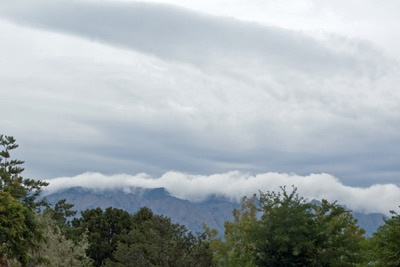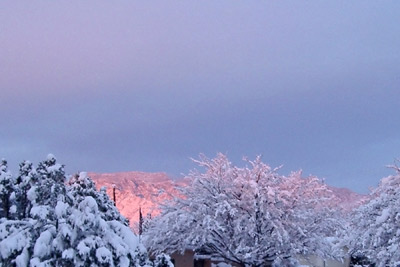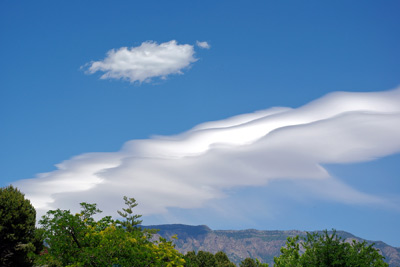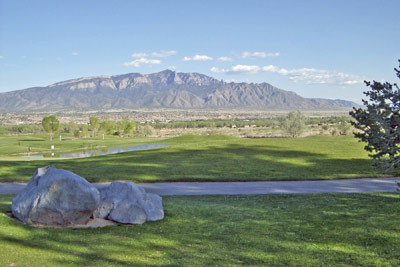MY MOTHER’S MOUNTAINS
Las Montañas de mi Madre
By Mary Hunt Webb
Posted Sunday, September 11, 2011

Clouds spill over the tops of the Sandia Mountains. [Photographer: Morris Webb, Jr.]
When I saw the clouds pouring over the Sandia Mountains one morning this last week, it took me back to a time when my mother was still alive and able to visit us in Albuquerque. At that time, we lived in a house that was in the foothills of the Sandias. From that perspective, it was impossible to see all of the mountains. One could only view a portion of the majestic vista.
During each visit, Mother made a habit of going to one of the east-facing front windows at some point during each day to stand there a while to take in the view.

This is my mother, “Kay” Hunt, as she appeared at our wedding. [Photographer: Morris Webb, Sr.]
Busy young mother that I was, I left her to her contemplation while I tended to things in the kitchen. I was happy to share the Sandias with her because I knew that Mother was born near mountainous terrain and had lived there until she was twelve years old. However, she had spent the rest of her life dwelling in comparatively flat regions. Consequently, she did not take for granted the spectacular grandeur of the mountains in New Mexico. She knew that when she returned to her home in another state, she would leave their splendor behind. Therefore, she was soaking in their beauty while she could.
She never tired of the way the mountains looked different in the morning, with the clouds spilling over the top, from the way they did in the evening with the setting sun reflecting a rosy glow across the rugged face of the range. Mother appreciated the fact that the deep pink color at sunset gave the name to this particular set of mountains because “sandía” (pronounced “sahn-dee’-ah) is the Spanish word for “watermelon”. I often caught Mother glancing at the mountains throughout the day to take in the unique panorama that they offered with the changing light and weather. When snow dusted the craggy crest, she took up her stance at the window to absorb its luster.

The rosy glow on the Sandia Mountains peeks between the snow-laden trees at sunset. [Photographer: Morris Webb, Jr.]
There is an old dicho (“saying”) that advises, “You can take the boy out of the country, but you can’t take the country out of the boy.” In Mother’s case, the revised version would have been, “You can take the girl out of the mountains, but you can’t take the mountains out of the girl.” The mountains resided inside my mother through the decades that she lived elsewhere.
Our young son, who was still in school at the time, did not understand or appreciate his grandmother’s need to revel in the glory of the mountains.
Seeing his grandmother standing at the window, he asked, “What are you doing, Nana?”
She did not turn her gaze from the view as she replied, “I’m looking at my mountains.”
“Those aren’t your mountains!” he protested. “They belong to everybody!”
Mother was not deterred by his logic. She spoke from a mature perspective when she replied, “They’re mine when I’m looking at them!”

Mountain wave clouds form over Sandia Crest, the tallest mountain in the Sandia Range, on a breezy June afternoon. [Photographer: Morris Webb, Jr.]
My mother’s attitude towards the mountains is similar to our relationship with God. We may wander away from Him, but He never leaves our hearts, our minds, or our souls. He is always there, waiting for us to return to Him, to soak in Him, and to revel in Him. His glory is ever fascinating. Like the face of the mountains, He may appear to change, but He doesn’t. What changes is our perspective of Him. As we grow, our attitudes mature. It isn’t God that changes; we are the ones that transform. Instead of taking our world for granted, we begin to realize that Someone bigger than us created the mountains, canyons, rivers, and oceans.
The prophet, Amos, summarized this understanding in Amos 4:13 when he wrote,
For behold,
He who forms mountains,
And creates the wind,
Who declares to man what his thought is,
And makes the morning darkness,
Who treads the high places of the earth—
The LORD God of hosts is His name. (New King James Version)
(See the Spanish translation of this Bible verse below)
Like the mountains, God may be too big to hug, but we can embrace Him with our hearts, minds, and souls. We can bring him to live inside us. As long as our focus remains on Him, He never leaves us.
Amós 4:13 "Porque he aquí, el que forma los montes, y crea el viento, y anuncia al hombre su pensamiento; el que hace de las tinieblas mañana, y pasa sobre las alturas de la tierra; Jehová Dios de los ejércitos es su nombre." (Reina-Valera 1960)

The Sandia Mountains show the splendor of spring. [Photographer: Morris Webb, Jr.]

